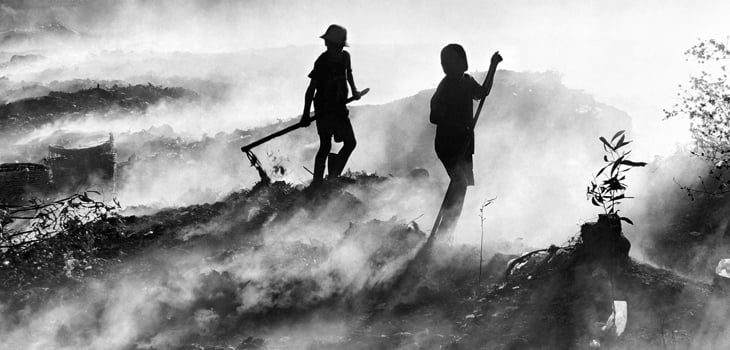Migrant children who don’t make the front page
London School of Hygiene & Tropical Medicine https://lshtm.ac.uk/themes/custom/lshtm/images/lshtm-logo-black.png Tuesday 15 September 2015
The recent image of the body of a dead three-old boy on a Turkish beach seized the world’s attention and provoked the worst nightmare of parents everywhere. This photo, which warrants the international outrage it has received, sadly only hints at the full panorama of childhood horrors that occur around the world each day.
In recent months while one migration crisis has followed another, alongside and worlds away from the children fleeing bullets and bombs, are unseen millions of girls and boys who are also suffering aborted childhoods and forced to navigate a universe of adult perils in the form of forced and trafficked child labour. But, what happens to the children who survive these abuses?
Some harsh answers to this question are provided by a recent study we carried out with 387 young survivors of child-trafficking in Cambodia, Thailand and Vietnam. Children as young as 10 are working as sea slaves on fishing boats to fill our catfood tins, making toys for our children, supplying sex for paedophiles, and being purchased as brides. Life for these children is often violent: one third of the boys and girls we interviewed suffered physical or sexual violence (or both) while they were in the trafficking situation. These children do not have enough food or water. When they are done working, they frequently sleep in overcrowded rooms on dirty floors.
Unlike most exploited child labourers, the children in our study managed to escape or were removed from these circumstances. Yet, as for their future, it seems that many of these young survivors cannot imagine the road ahead or don’t want to try. In the month before the interview, 12% told us that they had tried to harm or kill themselves. Yes, they were so bereft from their past or perhaps so hopeless about their future that they told us that they had tried to hurt themselves or end their lives.
For children who have experienced so much at such a young age, trying to make a better life is likely to be very difficult, especially for the more than half who screened positive for depression, the third with an anxiety disorder or the one-quarter suffering posttraumatic stress disorder.
One might hope for a return home for these children. But not all young trafficking survivors should or want to return home. Some come from abusive homes. Some feel guilt and shame making them worry about how they will be treated if they return home. Many fear further harm from their traffickers.
As distressing as these figures are, many children also showed us how compassionate and perhaps resilient they are. A large proportion of survivors were not highly symptomatic for PTSD or depression. Many of these children who were forced to prematurely cross through the threshold into adulthood stated that they had ambitions for a better future for themselves and their family. “I want to save money to open a grocery store, build a house for my older sister. I want to do a good job, and I don’t want to do this job again,” said one young sex trafficking survivor.
Millions of other children around the world are working in hazardous, often horrendous situations and are never identified as trafficked. These children are mostly invisible. The shadow of their work appears in the fish on our grocery shelves, on the pavements as they work or beg for money in tourist sites, and in the playthings that fill our own children’s toy boxes and the clothing sold from shop shelves.
As Graham Greene succinctly noted, “There is always one moment in childhood when the door opens and lets the future in.” But, he was probably not thinking: what happens when that door is opened by a child trafficker? For some trafficked children, the consequences can be dire in the short-term, possibly leaving scars that can last for a lifetime.
What can we do for the children who mostly remain out of the world’s sight and out of mind? First, for the children who survive, we invest in suicide prevention, with early identification of at- risk cases and offer of rapid medical and psychological support in crisis situations. We must also nurture their hopes for a better future by making sure they have the tools of counseling, education, a supportive peer group and good, safe jobs to build that future. We must help these future adults to discover viable alternatives to fend for themselves in a world that seems to be so hostile. Indeed, many children in our study were still able to describe ambitions for their future.
But, most importantly, we must demand that the world’s children stop doing dirty, dangerous and degrading work. This requires governments, businesses and supply chains and civil society to not only to work to end to child slavery and weed out child exploiters, but also to invest real money in programmes for children’s education, nutrition and good job training to ensure a safe and healthy childhoods, where the door to adulthood does not open until children are indeed adults.
Publication:
- Ligia Kiss, Katherine Yun, Nicola Pocock, Cathy Zimmerman, Exploitation, violence, and suicide risk among child and adolescent survivors of human trafficking in the Greater Mekong Subregion, JAMA Pediatrics. DOI: 10.1001/jamapediatrics.2015.2278
Image: Children working on field in Vietnam. Credit: ILO/Truong Huu Hung
LSHTM's short courses provide opportunities to study specialised topics across a broad range of public and global health fields. From AMR to vaccines, travel medicine to clinical trials, and modelling to malaria, refresh your skills and join one of our short courses today.